Crocs and Conservation in Abidjan
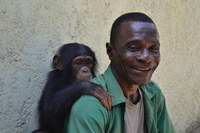
Matt Eschenbrenner, senior herpetology keeper and Dr. Ralph Zimmerman, head veterinarian, delivered much-needed equipment, trained keepers and worked with the animals at Zoo d’Abidjan in January 2014.
The zoo, located in Cote d’Ivoire’s largest city, is rebuilding after years of unrest and civil war. It houses the largest captive population of the critically endangered West African slender-snouted crocodile (Mecistops cataphractus).
Matt is passionate about crocodiles and put together the outreach trip, which was funded by the New Mexico BioPark Society’s Conservation Fund. In between catching crocs and sampling the local cuisine, he wrote about his adventures. These are excerpts of his travelogue.
So What is This Project, Exactly?
13 January 2014
Somewhere over the Atlantic
I love my job. Right now, I am 30, 000 feet over the North Atlantic going about 550 miles per hour on my way to Cote d'Ivoire, which is 8500 miles from my home. 6 months ago I never would have thought I would be in this seat on this plane. Traveling with me is my friend and trusted colleague Dr Ralph Zimmerman. He is our Head Vet at the ABQ BioPark. He was gracious enough to lend his expertise of all things reptile to this project.
So what is this project exactly? What the heaven are 2 country boys doing in the middle of a city that 7 million people call home?
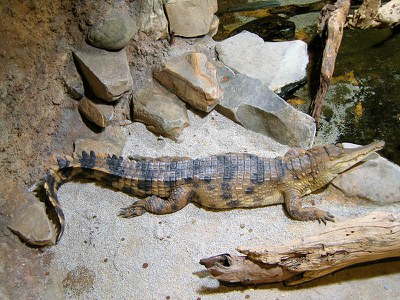
Well, situated in the middle of that metropolis is a zoo, and in that collection of animals housed at the zoo are 37 Mecistops cataphractus. That is Western African slender snouted crocs to the layman. The species is a candidate for a Critically Endangered listing on the IUCN Red List.
The Abidjan Zoo has the largest captive collection of cataphractus in the world. A permit is in the works to bring 6 of these individuals into the US to be ‘Founding Fathers’ (and mothers) in a breeding program. Of the 38 cataphractus in the U.S., 33 are related. Enter the Founding Fathers. Now we have a nice fresh stock of new DNA to help with genetic diversity! Hooray! Let’s make some croc babies.
During this trip we will be catching 37 cataphractus and separating out the Founding Fathers, doing health exams on the entire lot and implementing a croc training program. Since we are feeling crocky, we might as well add 21 Nile crocs to the exam docket. And last but not least 3 African dwarf crocs, who after the rest should be a Sunday drive to get ice cream while listening to Barry Manilow and being surrounded by kittens.
After the croc capture fun, we will assist in setting up a new incubator so they can get their own breeding going on and train their croc keepers the finer points of croc husbandry, i.e. how to keep all of your limbs.
Meanwhile, in other parts of the zoo, there are mammals and birds saying, "Hey, what about us?" Not to worry my friends, there will be plenty of time to make sure everyone is looked after.
You see, this project is about the Zoo as a whole, not just about the crocs. I want to form a partnership with these good people, to be there when needed, and help them succeed. In turn, I believe we can learn some things from them as well. They have faced adversity like I cannot imagine. They have been tested and beaten on, and they have endured. I think we can all learn a lesson from them about resolve.
We are honored to be a guests of the Ministry of Cote D'Ivoire and the Abidjan Zoo. And I am thrilled to be a link in the chain of helping bring these crocs back from the brink.
White-Knuckle Arrival
13 January 2014
Abidjan, Cote d’Ivoire
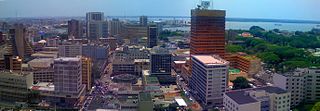
We piled into two small cars and proceeded from the airport to our hotel. This soon became a white knuckle roller coaster ride that kept me literally on the edge of my seat, and on the back of it, and on the floor, and at one point in Head Veterinarian Ralph Zimmerman's lap, and.... well, you get the point. The roads are not marked here and it is a virtual free for all.
Tomorrow, we tour the zoo and hit the market for a true taste of the city. I can’t wait.
Touring Zoo d’Abidjan
14 January 2014
Abidjan, Cote d’Ivoire
Ever have one of those days that really feels like 2 or 3 mushed together? That is today.
Doc, Kim, and I took a cab to a nearby supermarket and we did a bit of shopping. The supermarket was like ours back home, only with much more colorful packaging and words that I do not understand. Milk for example...impossible to find. You should have seen the look of disappointment on my face when I put back the corn flakes.
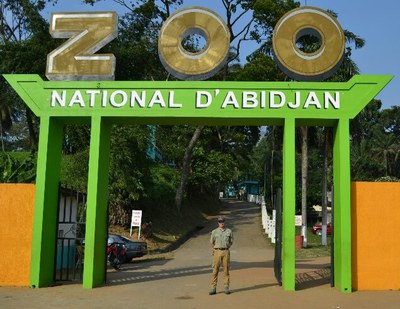
Richard Champion [leader of the Zoo’s rehabilitation] arrives, and we head to the zoo for the first time. This is what I have been waiting for! After a quick meeting with the director we are off on a VIP tour. We scoped out all the critters at the zoo. Chimps, elephant, crocs, wart hogs, snakes, all kinds of African hooved animals… In the end we agreed that this zoo has loads of potential and we have a basic plan of attack for the following week. The zoo visit ended with a meeting with the croc keepers and discussion about the croc captures in the days to come.
Tomorrow we will attempt to break down the language barrier and go over capture and training protocol. Scary and exciting. The keepers seem happy and interested in learning more.
Nice to Meet You, Too
15 January 2014
Abidjan, Cote d’Ivoire
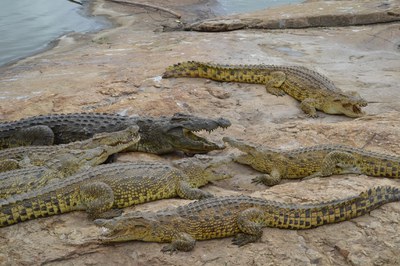
Doc and I arrive at the zoo at 8 a.m. where he will work with Soro, the Abidjan vet, and I will be teaching general protocol, husbandry, capture and health exam techniques to the croc keepers, who have never had any formal training.
First item on the agenda is following the croc guys and seeing how they work the animals. At one point a keeper moves a croc by giving it a nice whack on the head. Croc jaws and heads are loaded with integumentary sensory organs (ISOs) which makes their skin 10x more sensitive than ours. Needless to say, that practice has to go.
I set a pole on the ground about six feet from one of the Nile crocs just to see how she would react, and she quickly unleashed a nice large jaw pop and hightailed it as far away from me as she could get. This is croc speak for “I will rip your face off and wear it as a Halloween mask if you come at me again.”
Not great news if you need a target pole to train.
Spaghetti with kidney (I now have a favorite part of the goat to eat) for lunch and more training with the help of a French translator named Clovis. We’re having dinner tomorrow at the home of the Deputy Director of the Embassy or some fancy title like that. Sounds like a food fight just waiting to happen...
Chaotic Crocodile Captures
16 January 2014
Abidjan, Cote d’Ivoire
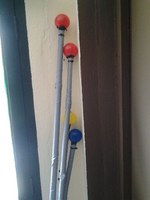
Upon arrival at the zoo I make the first ever targeting pole [a point of focus for animals that are being trained] in Abidjan zoo history. It is a 5 foot long section of bamboo completely covered in duct tape with a plastic ball at the end. I have tried to camouflage the bamboo pole so the crocs don’t associate it with punishment.
After a light lunch (since my stomach is really mad at me now), we geared up for Nile crocodile capture. We first selected a male with upper jaw abscess, and I have to give it to the guys-- they followed newly-learned protocol and secured the animal. He was examined and let go in a very bad mood.
Biggest problem is the language barrier. I know the procedure, but I don’t know it in French. You have to yell directions in an instant and I was having a hard time getting my point across. I am very glad that Matt S. was there to give direction when things got crazy. [Dr. Matt Shirley is a croc researcher from Univ. of Florida and manager of safari development at SFM Safari Gabon.]
We did visual exams on all 13 Nile crocs and caught the ones with obvious problems. Doc evaluated and treated various wounds, abscesses, growths, in-grown teeth and bite wounds.
We all went to the hotel and cleaned up for the fancy dinner. We went to the house of the Deputy Director of the US Embassy. There were a few other members of the Embassy present including a British friend we met the other day at a café. He knows the Queen. He is also hilarious and had many good tales to tell, including a little crude humor. It was a wonderful dinner and we were happy to have multiple conversations at once in English.
Well-Oiled Croc Catching Machine
17 January 2014
Abidjan, Cote d’Ivoire
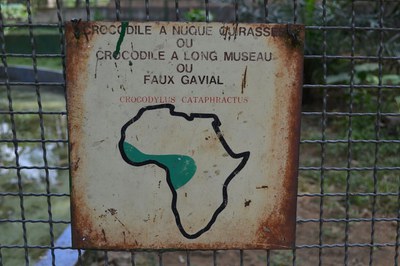
Today started with capture of the cataphractus [West African slender-snouted crocodiles]. All of the equipment was set up including poles, ropes and weigh scale. We walked around the enclosure, singled out the potential ‘Founding Fathers’ and marked them for easy identification. We went over the plan with the crew and chose the first croc.
Things went south right away. The guys were working as individuals and not communicating. The crocs were running the show and we were only able to capture and examine three that morning.
After lunch, we had a talk about teamwork and the afternoon captures went perfectly. We caught, examined and treated three, one right after the other. We became a well-oiled croc catching machine.
After a few more captures I began letting the Abidjan keepers make the calls, deciding where to station the crocs and how to separate them from the group. They performed superbly and we ended up catching and examining 11.
The day had totally turned around from earlier that morning when I was thinking, "What am I doing here?" to being very proud that I was. We had a final talk and we all told them what a great job they did. They all had huge smiles on their faces.
Our interpreter Clovis even jumped into the capture from time to time. That guy is invaluable and there is no way the day would of ended positively if it wasn’t for him.
Today Was a Very Good Day
18 January 2014
Abidjan, Cote d’Ivoire
We gathered in the morning and prepped for more captures.Today we are searching for two good-looking male cataphractus (West African slender-snouted crocodiles) to accompany the four females that are heading to the states. The Abidjan keepers now have the capture procedure down and run the show from start to finish.
They captured two males by the book. The second one was very dark and beautiful, weighing in at 350 pounds. We now have 9 potential crocs that will be narrowed down to 6 based on genetic workups done last year.
After choosing the males, we re-caught another from the previous day that has some bone issues and treated him with injectable calcium. Lastly, we captured a female and gave her an eye exam. It has been a complete 180 from our messy start and I couldn’t be happier.
The guys were treated to lunch at a nice little Vietnamese place and we broke for the day. I appreciated having a little time off to clean my capture clothes...I am completely filthy and look and smell as though I have been wallowing with pigs for the past two days.
Dinner tonight was at a really fancy Ivorian American fusion place. Quite delicious. I am also excited to be able to sleep in a little in the morning. We are meeting at 10 a.m. to head east of Abidjan to Assinie and look at a croc farm that is looking to swap a few of their cataphractus with the zoo. We are staying at a hotel near the ocean which is owned by the manager of the croc farm. I hear it is beautiful. I welcome being away from the big city for a day or two.
(Photo: Abidjan Keepers with Kim Lovich, San Diego Zoo, and the ABQ BioPark’s Dr. Ralph Zimmerman and Matt Eschenbrenner)
Searching for Suchus
9 January 2014
Assinie, Cote d’Ivoire
So do you remember yesterday when I was excited about getting extra sleep? Well that was quickly forgotten about when an annoying, loud banging started at 6 a.m. in the room next to me. They are renovating the hotel and decided to work early on Sunday so they can leave early. Great for a worker. Bad for a tired hotel guest who has been catching crocs for three days.
We go on our merry way, nine people crammed into a small transport van and a Mercedes headed for Assinie. Later, we arrive at our hotel which is called the African Queen and it is wonderful, situated on a lagoon not far from the ocean. We meet Manu who owns the place and operates the croc farm we are here to look at, so we get to use the hotel at a large discount. We dump our bags and head to the croc farm which is quite nice.
Total they have almost 200 crocs of all sizes: suchus, osteolameus, and cataphractus, all of which are fat and happy. No real issues there.
We came across a sulcata tortoise in need of a beak trim, a civet that may be parasitic and a camel that needs a little treatment. Their venomous snakes are mislabeled and in badly designed enclosures, but they all looked healthy as well. The farm was clean and pretty.
After the tour, we head out with two of the keepers to go looking for wild suchus [West African or desert crocodile]. They lead us astray a few times before showing us possible croc territory. We take off through saw grass and into waist deep water, guided only by our head lamps. When you shine your light at a croc, their eyes shine back like a candle with a reddish tint. We look everywhere, up, down and around thick vegetation. Frogs are hopping and insects are calling along with the birds, but no crocs or snakes.
We are filthy and soaked…I hope my Gortex boots dry out from all this water before my feet rot off. It was very much fun. Even though we didn’t find any tonight, not many people can say they trounced through tropical terrain in West Africa looking for crocs.
Wild Croc Encounters
20 January 2014
Assinie, Cote d’Ivoire
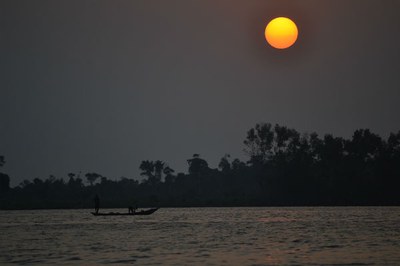
Today was the first day since arriving that we had a real bit of free time. In the morning I bum around the hotel, mostly writing on the tablet. Around 1 p.m., a driver takes a group of us in a little boat across the lagoon to the ocean. The hotel has a little grill set up right there on the beach. It is practically deserted. A beach like this back home would be swarming with people. Matt S. and I hit the water and get thrown around by the waves a bit before being yelled at to come in. Apparently 20 or so people were sucked out and drowned here last year. At least I can now say that I swam in deadly ocean currents and survived. That makes me sound pretty tough right?
About a half-hour after dusk, we get our head lamps and spot lights. It’s croc time. We slowly guide the boat around the mangrove islands looking for that red glow of the eyes. After about 20 minutes, Matt S. spots something in the distance. We cut the motor, drift closer and I hear him whisper, “Croc.” He hops into the water which is about three feet deep and I follow, having a hard time getting a foot hold on the muddy bottom and oyster shells. Eventually one of those shells slices into the side of my foot but I keep moving.
The croc allows us within a few feet; it is a little suchus, about 2 feet long. It takes off along the shore line and we follow, then it heads the opposite way while we pursue. Matt and I split up and I flush it towards him, but it is a slippery sucker and reaches the middle of the lagoon. We see its eyes shine one last
time as if saying: "Nice try, losers." About 30 minutes later, we encounter another, about twice the size of the first, in a narrow channel between mangroves in deep water. We leave him be. My first experience with wild suchus. Amazing.
Upon return to the room, Dr. Zimmerman, who was ill and spent most of the day in his room, is still laid up but feeling much better. I show him my foot and ask if I am going to die and he sort of said no. We just need to watch it. I head off for some late night food. It’s past 11 at this point and I am beat.
Back to Abidjan in the Rain
21 January 2014
Abdijan, Cote d’Ivoire
Tuesday was a wash, literally. By the time we reached Abidjan and did a load of laundry, the rains started. Luckily most of our clothes were already soaking wet so it really did not affect the drying process. By the time the rains stopped and we had a chance to hit the zoo it was already pretty late.
Kim Lovich, who is an associate curator at San Diego Zoo Global, has been working with the Ivorian Ministry on the cataphractus import to the U.S.. She is leaving tonight, so we had one last dinner together. Looks like everything is prepped for the croc shipment. Logistics have been arranged and we promise her that the crocs are in good hands before she heads back home.
Preparing Endangered Crocs for Trip to U.S.
21 January 2014
Abdijan, Cote d’Ivoire
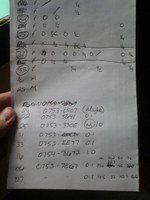
I sit down with Matt S. and go over the genetic results on the cataphractus. We make a matrix and eliminate the crocs that are too closely related. I now have the Trovan® [microchip ID] numbers of the six that will be the Founding Fathers of all future pairings in North America in my hand, in my own handwriting. Pretty exciting!
Now that the hard part is done, all we have to do is catch them. Right…
The crocs are still marked from the other day, so identifications are easy, we just have to worry about the other 27 in there who won’t be happy to see us. The crocs have been in deep water the last few days, so we drain the pool and see a nice even distribution of crocs. Overall the captures went by the book, with a few hang-ups here and there, including Deputy Zoo Director Richard Champion splitting his pants. This received a huge ovation from the onlookers.
We identified the six crocs destined for the U.S., marked them for quick ID and released the ones staying here.
Mission accomplished, time to relax.
Busy Day for Doc
23 January 2014
Abdijan, Cote d’Ivoire
I was up almost all night last night with my stomach killing me and running a fever. Last night for dinner, we went to a little open air market with many "grill mamas" who have their own little stands. You select your dinner, usually fish or chicken, and they prep it for you over the fire. My chicken tasted good, so I’m not sure if it, or the drink, was the culprit of my 24 hours of heck. So I was useless today.
The big fish order we have been expecting turned out to be a school of minnows. Not really, but when we ordered 80 kilos a week, apparently the person we talked to heard “ten.” Our goal was to begin croc training today, but the only ones interested in food were a few females that had been left alone all week long. We still have a week to train, if more food can be secured and fingers crossed that we can at least get off the ground with the program. I will cover everything with Clovis, our interpreter, before I leave and we will keep in touch. At least I will be able to see the training from afar.
Dr. Zimmerman had a busy day treating critters. He examined a red kite which is a medium-sized bird of prey and worked some magic on it. Also discovered that an osteolaemus [dwarf crocodile] we have had an eye on could potentially be blind. He is prepping for a baboon exam tomorrow and took a close look at some tortoise shells. The new bush buck that arrived yesterday is looking great after night one, but a vervet monkey died.
We found out that all of the monkeys are fed from the same pile of food in the enclosure. This one was at the bottom of the pecking order and essentially starved to death. This is the perfect example of basic animal care that the keepers here have never been taught.
Last bullet point on the docket was the elephant. She has a chronic bacterial infection in her eye and Doc rinsed it out with Gentocin. Now, everyone is off to get dinner and I am crashed in my room like I have been all day. I think I am over the hump and ready for tomorrow.
Critter Care
24 January 2014
Abdijan, Cote d’Ivoire
This trip is like a rollercoaster. Ups, downs, goods and bads, scary and exhilarating and when it is over you run off and want to get right back in line and do it all again.
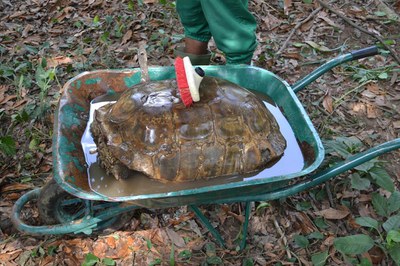
Yesterday, I was sick and Dr. Ralph was slammed. Today, I am feeling great after some rest and ready to help the Doc do his thing. We start with two sulcata tortoises that have shell issues. One we put into a wheelbarrow where the keepers scrub her shell and give her a nice iodine soak for about 20 minutes. The other has a hole in her shell that went down to the body cavity at one time. She had been treated by a previous vet over the summer and upon examination, we find that the shell is healing great, so we clean and repack the cavity with gauze and antibiotics for good measure. I had not yet worked with the two keepers helping us, but they are awesome; they listen, are interested, and follow direction.
After that we catch a small osteolaemus [dwarf crocodile] that is looking thin and we determine that he is blind. We give him fluids and instruct the keepers to keep close watch on him and make sure that he gets his fair share of grub at feeding time.
Then we meet with the croc guys to go over the training protocol. Three nice big buckets of fish have arrived and are waiting. We spread out around the pool, each keeper with a target pole. First thing is getting the crocs comfortable with having people near them.
Second is getting them to see the training pole as a positive thing, so today all we do is the audio cue, which is popping with your lips and feeding the crocs while holding the target pole. A few crocs respond and eat right away and a few even allow me to touch them lightly with the pole, after which they get a big reward. Small steps, but not bad after a solid week of being caught for medical exams.
After training, we get some big news: Our box of supplies, including incubator parts, has arrived! It’s like Christmas morning! All in all, it’s been a positive day, and we needed that. We helped some animals live longer and healthier and taught some keepers how to better care for their critters. I will take that any day.
A Heated Search for a Refrigerator
25 January 2014
Abdijan, Cote d’Ivoire
I have sweated more today than I have all the other days of my life combined. I think I am almost down to my birth weight. We all met up this morning and hitched a ride to a nearby market place in search of a broken down fridge to use as our cataphractus [West African slender-snouted crocodile] egg incubator. Doc Zimmerman and I also were on the lookout for a few trinkets to take back home.
Matt S. wandered one direction and Doc and I went in the other. Matt can handle himself: He is twice the size of most of the people here and can speak the language. Doc and I quickly realized, however, that this market place was not for us. It was a huge building, set up like an indoor flea market, the air was stale and stuffy and narrow passages crisscrossed in every direction. It must have been 100 degrees in there and on a really humid day like today, I was soaked in no time. We left and hit a few more stands in a different part of the city.
Meanwhile, Matt S. sends a picture of the winning fridge and negotiates a price, delivered. It is a nice looking soda fridge that was probably used in a restaurant or store. It has a glass front and will clean up to a sparkling shine. We head to the zoo and at this point I have been outside for six or so hours. I am drenched and beat.
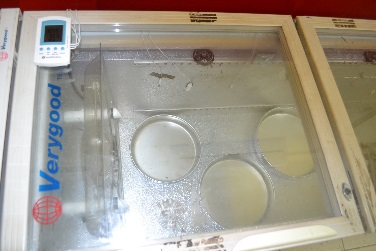
The fridge arrives and we set it up in the clinic for the time being. The keepers strip off all the coils, motors, and such which the zoo will resell. We hook up the incubator for the first time. It runs on 110 volts which is used in the U.S., while Cote d'Ivoire runs off of 220. I brought along a nice heavy transformer (not robots in disguise) that changes the voltage from 220 to 110 so our American stuff can work. I crossed my fingers, plugged everything in and…Victory on this day belongs to me!
Everything worked like a charm and the super power outlets did not set the fridge, the clinic or the zoo on fire. We set the temp, monitored it for a bit, and called it a day.
Over the next week we will keep a close eye on it to make sure everything is square before we head back to New Mexico.
We have been invited to the Presidential Palace tomorrow in Yamoussoukro. It was built many years ago by the president at the time when he up and moved the capital of Cote d'Ivoire from Abidjan to Yamoussoukro.
He then had the awesome idea to surround the palace with a moat and throw killer crocs into it. I admit I like his style, it sounds a lot like my dream home. It’s a two-hour ride by bus and we will spend the night in the city. Should be a good time!
Managing Sacred Crocs
26 January 2014
Yamoussoukro, Cote d’Ivoire
We packed up our rooms this morning, took a cab to the bus station and were quickly on our way to Yamoussoukro. We are greeted at the bus station by the Minister of Water and Forests. He first took us to our hotel, which is still decorated for Christmas, then to his house, then his office to discuss a meeting tonight to address the troubles the good people here are having with crocodiles.
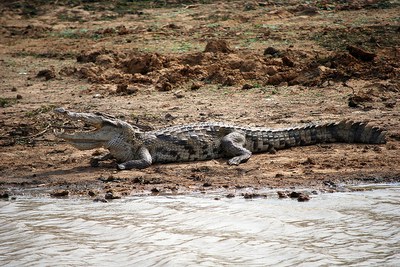
These folks, the Baoule, have a history with crocodiles going back many hundreds of years. Baoule legend has it that the tribe traveled across the river Akounde Kale on the backs of hippos and crocodiles before settling in the area. The name of the river Akounde Kale literally means "if you want trouble, touch me."
So jump forward to the 1980s. President of Cote d'Ivoire Felix Houphouet-Boigny travels to Mali and becomes fascinated with their Sacred Crocs. He arranges to have some brought back to Yamoussoukro and creates what is now the Presidential Palace, adding them to the grounds. These crocodiles have reproduced and the little ones have managed to leave the moat and are now abundant in surrounding lakes and land in between the villages, roads, etc.
The Baoule believe that the recent violence in Cote d'Ivoire has angered the Water Spirit, and the Spirit has manifested its power into the crocodiles to take revenge. There have been at least three deaths in recent years. The problem, however, is that the Water Spirit is sacred and the crocs are sacred, which means that you can’t kill a croc.
Looking for help, the Baoule recently went to their sacred tree, which they call "Papa," and is located within the palace. Here, they prayed to their departed chiefs and made a sacrifice to the Water Spirit, and were then granted permission by the Spirit to take care of the croc problem. Enter…us. They heard that we are all in the country and requested our presence at this very important meeting which included 14 men sitting in a semi-circle, all of them chiefs of prominent families and villages.
Tomorrow, we will tour the palace and surrounding lakes. Captive croc management is what they need and I think I know someone who might be able to help.
On our way to dinner we stop in front of the palace. Sitting there is the biggest suchus I have ever seen. Easily 13 feet, just hanging out with a three-foot fence separating us. I now see first-hand the massive problem.
Crocs Run Amock
27 January 2014
Yamoussoukro, Cote d’Ivoire
The Presidential Palace is a massive complex with three sacred lakes in front containing crocodiles. We receive permission to tour the sacred lakes and stop at the main feeding station where many crocs are beached on a concrete island.
When the keeper calls, roughly 30 of them swim up, and at the corner of the island, I see a head emerge and a mammoth beast high-walks out of the water. He lumbers towards the others, and the ground practically shakes with his steps. Godzilla comes to mind. reaches a good area to be fed and flops down with a thud. We are all in awe that there are suchus that big in this lake.
Later, we tour the inner wall of the lake directly in front of the palace. There is a concrete walkway, about the size of a two-lane road and approximately 300 yards long. Torrential rain falls almost daily during the rainy season and has washed away the foundation that these slabs were built on. In addition, with no place to nest and lay eggs, the crocs are tunneling their way out of the lake, entering the palace grounds and surrounding village to nest. We are looking at collapsed concrete, fallen guard rails, croc tails hanging out from under the ledge. A real mess.
Another problem. Many drainage corridors run from the lakes into the village with no gate or mesh to stop the crocs from entering. They can literally cross the city.
Among other suggestions that will be submitted to the Governor, we propose tearing out the entire crumbling walkway and turning it into a large beach--give the crocs a place to nest and they might just stay put.
After lunch, we attend one last meeting at the house of the Governor with many of the chiefs from last night. Here, the Governor presents us with gifts of beautiful fabric, hand made by the Baoule in the village. Adorned with unbelievably intricate sewing and patterns that have specific meaning to the tribe, each piece must have taken months to create. I am so honored and lucky to receive such an amazing gift from this powerful man in his own home.
As we are leaving he says to me in English: "I am more American than you think," and points to his garage where a nice big Harley Davidson is sitting next to a Dodge Durango.
We hitch a ride back to Abidjan with the minister who pops in a CD during the trip. In my wildest dreams, I never thought I would be flying down the highway from Yamoussoukro to Abidjan in Cote d'Ivoire, watching the sun set, holding handwoven Baoule fabric from Governor Augustin Thaim, and listening to "The Gambler" by Kenny Rogers.
Croc Lessons for Kids
28 January 2014
Abdijan, Cote d’Ivoire
I needed some good sleep and got it last night. Doc and I are back at the zoo pretty much on our own. First thing I work on is croc stuff, of course. The cataphractus enclosure is under construction and they are installing new ramps from the pool to the land to ease the passage of the crocs.
One pleasant surprise today was an American school showing up at the gates of the zoo. All speaking English! So they got a little lesson in crocs while I got to have a conversation with some interested children that can actually understand me. They had some great questions and afterwards we used one of the parents as a translator between myself and the croc guys. Win, win.
We moved our new incubator over to the future education building. Got everything set up and will continue to monitor the temps for the rest of the visit. I think everyone there is pretty excited to have a working hot box to put the eggs into in a few months.. Come on croc breeding season!
End of the Adventure
29 and 30 January 2014
Abdijan, Cote d’Ivoire
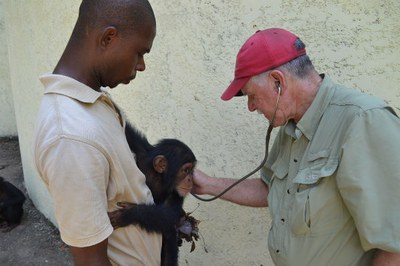
The last couple days have been full of... brace yourself... mammal stuff. We got some weights and did health inspections on three little chimps and shuffled some baboons around into bigger and better enclosures.
We have been keeping a very close eye on the incubator that we made by converting a used refrigerator, and the temp is holding steady. I went over the croc training program with Clovis, our translator, so that he can write it up in French and asked him to attend the training sessions with the keepers and keep me updated. We also discussed croc egg collection and handling.
Lastly, we sat down with the croc keepers to review everything we had done in the past few weeks. They thanked us and told us that they want to continue improving and developing as keepers. I hope they stay motivated. I found out recently that the head keeper here at the zoo will be attending AZA Croc School through a scholarship that will pay for the trip to Florida. He is the first attendee from Africa. Really great news.
We closed Thursday with a meeting with Col. Gouesse Lancine, the Chief of Staff of the Ministry, to discuss the potential of the Zoo National D'Abidjan. He repeatedly stressed the need for outside training and the desire to improve the zoo all around. We have been invited back whenever we please.
Time has flown by the last few weeks and this adventure is almost at an end. The experiences and people I have met here will stay with me always. I have been called “Croc Specialist” for weeks now, and although I do not consider it fully deserved, I also have not corrected anyone.
I will not soon forget the first tour of the zoo, catching critically endangered African crocs, meeting and working with the keepers. The owl that visited me in Assine and getting tossed around in the ocean. The children in their fishing boats and the dawn tour of the lagoon under (I was informed) millions of bats. New and interesting food, eating rat and snail and paying the price for street chicken. Chasing wild suchus and wading through waist high swamp water while listening to the frogs’ chorus. Our audience with the Baoule, and the massive man-eating crocs of Yamoussoukro. Assisting an entire village with a deadly problem. The Governor and his Harley, the gift of the fabric. Barely running cabs, haggling over prices and all of my new friends at the market. Smog, people everywhere. Matt and Emily, Richard and Craig, Clovis and Clement. The amazing, the frustrating, simple and complex, wonder and awe, anger, inspirational people, surreal moments and Kenny Rodgers. All of these feelings squished into 19 days, it was a crazy ride indeed.
I hope to see this zoo reach its potential and I will do my best to assist with the croc program no matter how far away from this place I am. My thanks to Cote d'Ivoire for having us, and until next time, I bid you, adieu.

